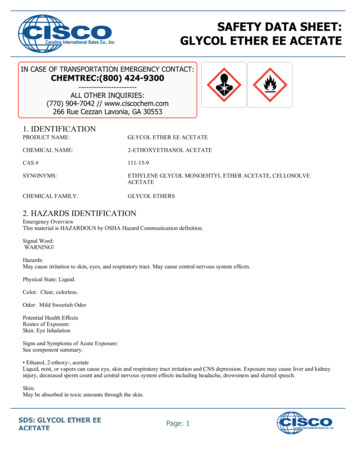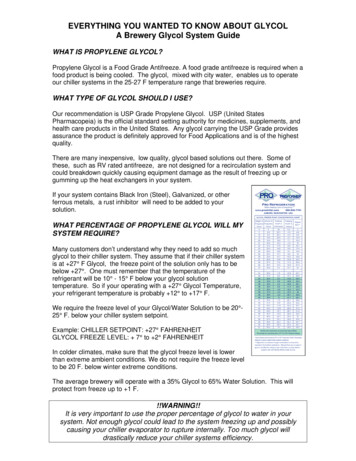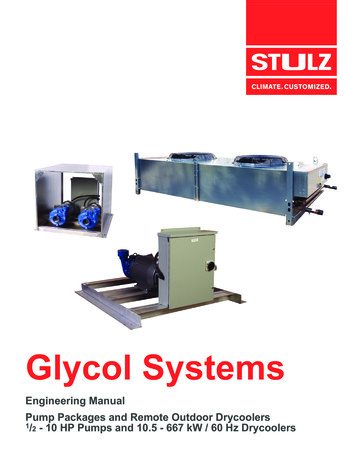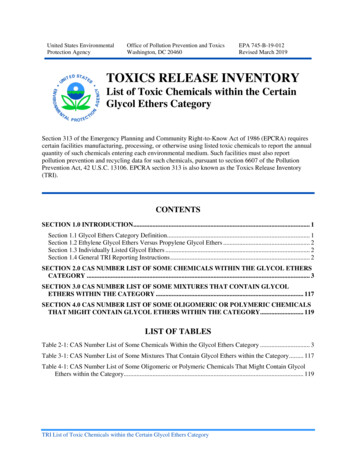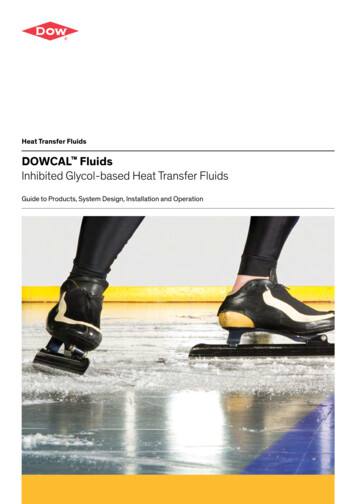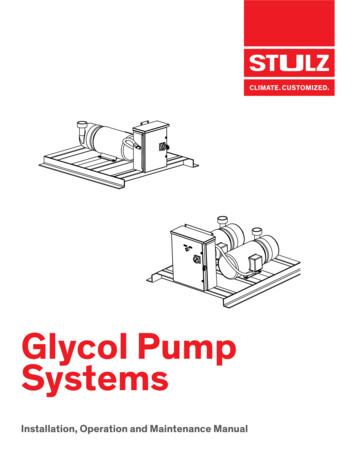
Transcription
MEETING THE CHALLENGES OFGLYCOL DEHYDRATIONA White Paper byJosh Schmidt, Viking Business Development DirectorBrad Powell, Viking U. S. Sales ManagerKyle Benning, Customer Solutions Application Engineering Manager
GLYCOL DEHYDRATION CHALLENGESIntroductionWhile servicing the pumping needs of energy customers (oil and gas producers/mid‐streamers), Viking Pump received multiple inquiries from engineering leaders about the feasibility of developing a fit‐for‐purposepumping solution for glycol circulation in the natural gas dehydration process.Although we were not glycol dehydration experts at the onset of this endeavor, Viking Pump did have previousexperience, and best‐in‐class solutions, in applications with similar challenges: pumping thin liquids at high pressures (crude oil pipeline injection – LACT) pumps in high temperature conditions (hot oil fryer market) encountering abrasives (asphalt pumps, sugar pumps, etc.) pumping glycol for heat trace or cooling providing critical leak‐free or explosion‐proof solutions to energy companies (API line‐up).Viking engineers proceeded to apply their unique combination of pumping application knowledge, to addressthe requirements of a new/challenging market, where few pumps, if any, were designed to meet the growingneed for motor driven pumps.As part of design and development of a new pump specifically engineered for the natural gas glycol dehydrationmarket, we researched and studied the challenges of this critical gas production process. Our goal was toenhance the pumping experience at glycol dehydration facilities concerned with absorbing the water to attaina high‐quality end product, while also reducing pipeline corrosion and eliminating line blockage caused byhydrate formation. The white paper is an opportunity for us to share what we learned over the years and tooffer solutions, from a pumping perspective, to a varied audience—from fabricators of gas productionequipment, to oil and gas producers, engineers, plant managers, maintenance teams, and purchasers. In otherwords, the whole supply chain involved in designing, operating, servicing, and purchasing dehydrators will findthis information of interest.BackgroundWhy dehydration is neededDehydration is a critical step in the treatment of natural gas before it can travel through transportation pipelinesand ultimately be sold to end users. Initially, the untreated gas contains waterand crystalline solids, or hydrates, both of which can damage downstream By definition, glycolpipelines and other equipment (by freezing/hydrate formation, creating iron dehydration isoxide buildup/rusting, forming mineral deposits that can clog the system, etc.). essentially a liquidHydrate formation is especially problematic, as it can occur at above normal desiccant system for thefreezing temperatures due to increased pressure, putting valves at risk removal of water fromthroughout the entire pipeline/transport system. This necessitates the natural gas and naturalseparation of water from the gas early in the process.Water not only has to be removed in order for gas to be transported, but theproduct also has to meet strict pipeline specifications for transfer and deliveryto the customer. In most cases, the natural gas must be dried to a 7% dew pointor less. A failure to be “in spec” for moisture content can result in less profits.WHITE PAPER COPYRIGHT 2019. VIKING PUMPgas liquids (NGL). It isthe most common andeconomical means ofwater removal fromthese streams.P A G E 1
GLYCOL DEHYDRATION CHALLENGESThe dehydration processThere are different ways to dehydrate gas, the most common way being to pump triethylene glycol (TEG) againstthe natural gas stream. However, with gas coming out of the ground at pressures as high as 10,000 PSI, thepressure has to be reduced (choked) to 1,440 psi max. Not all positive displacement (PD) pumps are capable ofovercoming this pressure as they generate flow, or handling the very “thin” viscosity of TEG for that matter.Also, note that many pumps struggle with the high temperature requirements of glycol dehydration. The glycolis typically 150 F to 200 F at the booster pump, and must be within 20 F of the gas temperature to ensureoptimum dehydration levels.But pumping TEG against the gas stream at the wellsite is just the beginning. There are other points ofdehydration in the natural gas stream as it travels through the entire process—from production through delivery(see Figure 1). And pumps are needed at each of those points. Points of dehydration in natural gas streamFigure 1. Natural gas production and delivery process diagram.Dehydration methodsThere are several types of dehydration methods employed in the treatment of natural gas, including: Dry Desiccant – a single‐use absorbent materialMolecular Sieve – regenerated synthetic porous materialTriethylene Glycol (TEG) – used in 80% of dehydration applicationsNote that the TEG method is the entry point for Viking Pump to participate, as pumps are an integral part ofthe glycol skid (see Figure 2).WHITE PAPER COPYRIGHT 2019. VIKING PUMPP A G E 2
GLYCOL DEHYDRATION CHALLENGESFigure 2. Glycol dehydration skid components, including: Contact Tower, Reboiler, Surge Drum, Flash Tank, HeatExchangers, Strainer/Filters, and Pumps.Glycol Dehydration ChallengesThe main challenges associated with the glycol dehydration process are as follows: Higher pressures – Up to 1,500 psi differential requiredThin viscosity – TEG is thin, and changes with operating conditions (70 F 49cP to 200 F 4cP). Effectiveabsorption happens when glycol is within 20 F of natural gas at the tower (see Figure 3).24/7 duty cycle – Requires sturdy, reliable pumps with long service wear to avoid costly downtime.Abrasive particles – Mineral deposits, salt, iron dust, etc.Thermal shock on startup – Glycol inside the pump can be 200 F, while pumps are also exposed toambient atmosphere temperatures outside, resulting in temperature deltas between pump and glycolthat could exceed 150 F. (See Startup section for recommended steps.)Remote outdoor locations – Require pumping equipment that can withstand harsh environments.These inherent challenges call for specialized pumps to ensure successful dehydration operations.WHITE PAPER COPYRIGHT 2019. VIKING PUMPP A G E 3
GLYCOL DEHYDRATION CHALLENGESFigure 3. TEG viscosity versus temperature chart.Viking Pump SolutionsWith over 105 years of experience providing positive displacement pumps for industrial use, Viking Pump has along history of designing engineered solutions for tough applications, like glycol dehydration. Now, Viking hasthe product suited for this specific application.High performanceViking Pump’s external gear GL‐407 Series and GL‐410 Series offera reliable pumping solution for circulation of TEG in natural gas glycoldehydration systems. These high‐performance pumps fulfill a widerange of application needs, as shown in the chart below (Figure 4).Figure 4. Viking glycol dehydration pump performance chart.(Refer to the company flyer on these pump series for more details.)WHITE PAPER COPYRIGHT 2019. VIKING PUMPP A G E 4
GLYCOL DEHYDRATION CHALLENGESBy design, the pumps are constructed to address unique challenges commonly encountered in the glycoldehydration process, such as filtration, startup temperature, pipe strain, and even priming the pump.FiltrationFiltration is key to maintaining flow rate stability and accuracy. This can be challenging when some, or all, of thefollowing glycol system circumstances exist:. Particulate contamination — Many glycol systems are decades old, containing potentially degraded glycolthat could be contaminated with particulate from years of use, e.g. salt, sand, and metal particles fromcorroded or failed pieces of equipment piped into the system, including pumps. Poor maintenance — Glycol dehydration facilities vary in their operating parameters and procedures,dictated by the gas itself or where the well is located, as well as different preventative maintenanceschedules and processes. Pumps can become partially “starved” by dirty or clogged filters, or seeunfiltered glycol entirely. Lack of monitoring — Some sites have limited electricity availability, limiting the amount ofinstrumentation they can use to closely monitor the glycol dehydration process. This can lead to gasflowing down the pipeline out of spec. And because the pump needs to stay in operation to maximizeprofit, if it does go down, start‐up procedures are often circumnavigated to get the system back up andrunning as soon as possible (see Start‐up Steps below).Viking engineers were well aware of filtering pitfalls when designing pumps for the glycol dehydration market,therefore, the pump construction is robust and bulletproof enough to not only operate in clean, new glycolsystems with state‐of‐the art monitoring, but also in a 30‐year‐old system with dirty, abrasive glycol and limitedinstrumentation. The construction materials, features, and clearances were selected based on a century’s worthof experience to ensure the pumps could manage the extreme variables that might be faced in the field.To optimize the lifespan of these pumps, Viking recommends the following filter guidelines: Use the industry standard filters, which appear to be 20‐30‐micron mesh filters.Put a magnet into the filters to help capture any metallic fines that may be trapped in the system. Thesemetallic fines can be very abrasive, so using a magnet with the filter to optimize material collection out ofthe system is ideal.o Metallic fines can even be present in brand new systems, due to weld beads breaking off into thenewly welded pipes.o Previous pump failures most likely introduced additional metallic fragments into the glycol system,which would stay trapped there until removed through filtration.Startup temperatureA crucial part of pump startup is getting the pump within the 100 F acceptable temperature delta betweenpump temperature and glycol temperature to prevent a thermal shock situation that locks the pump up. Themost accurate way to do that is to utilize the “temperature probe” access holes in the pump and a temperaturemonitoring system to measure pump temperature during startup.Viking Pump’s GL‐410 model is specifically designed for 150 F thermal shock resistance Viking glycol pumps arealso available with a temperature probe that allows for monitoring the pump temperature on startup. Each ofthese pumps come standard from the factory with a drilled and tapped port to accommodate the temperaturemonitor. The temperature probe produces a signal that is linearly proportional to the temperature. Viking offersWHITE PAPER COPYRIGHT 2019. VIKING PUMPP A G E 5
GLYCOL DEHYDRATION CHALLENGEStwo different temperature probe options, a Type‐J Thermocouple or a Platinum RTD, each available in either aweatherproof or explosion‐proof rating.However, not every system has the capability to support sophisticated temperature probe instrumentation. Ifusing an infrared (IR) gun to measure temperature, Viking recommends painting everything in the system onecolor, i.e. if checking pump temperature and temperature of the pipes, both should be painted the same color.The paint often holds more heat than an unpainted portion, and different colors in the wavelength spectrumwould read differently on the IR gun, even if they were the same temperature. So, making everything the samecolors ensures that using an IR gun for temperature monitoring can be as accurate as possible.Start‐up Steps:Our recommended start‐up procedure assumes a situation where the pump and glycol temperature differentialexceeds 100 F. If the measured delta is less than 100 F, jump to step 3.1. Run the pump for 10 seconds to introduce initial system glycol to the pump. Then, stop for aminimum of 15 seconds,2. Repeat Step #1 a second time. Then, measure pump temperature. Repeat Step #1 until temperaturereaches the required maximum delta.3. Run pump continuously and slowly bring up the system pressure. Once this is done, the pump cannow run continuously at the desired speed.Pipe strainPipe strain can cause misalignment and stress on the pump; and is one of the most common reasons why pumpsfail prematurely. To reduce pipe strain on the pump ports, Viking Pump recommends the use of flexible hoseconnected to the suction and discharge ports. Pump design is not acceptable for rigid piping, unless piping iscustom‐cut specifically for the Viking Pump glycol unit and the piping adequately supported with pipe hangersand/or supports.Viking Pump also recommends using a liquid pipe sealant/dope for the piping that is threaded into the NPT portson the pump. DO NOT USE TEFLON TAPE, as this alters the pipe OD and runs the risk of cracking the pump ports.Priming the pumpAnother common concern with glycol applications is priming the pump, as it relates to Net Positive Suction Head(NPSH), a measure of the pressure on the liquid being pumped. Viking’s rotary positive displacement pumps areinherently self‐priming, i.e. they have the ability to evacuate air from the suction line, which creates a reducedabsolute pressure at the suction port, promoting flow to the pump port by pressure differential. The pump’spriming ability is a function of pump speed and the internal clearances within the pump. Tighter pumpclearances result in better priming ability. Faster pump speeds also increase priming ability. A pump with wettedinternals (residual liquid/lubricants) will always prime better than a dry pump. Viking’s line of Glycol DehydrationPumps have tight clearances and, thus, they are excellent at self‐priming.WHITE PAPER COPYRIGHT 2019. VIKING PUMPP A G E 6
GLYCOL DEHYDRATION CHALLENGESMini Case Study: Marcellus-Utica ShaleArmed with a new line of Glycol Dehydration Pumps, Viking sales targeted the leading natural gas producingregion in the United States—the Marcellus‐Utica Shale. Almost the same size as the Permian, this area has beennicknamed “The Beast in the East,” spanning Ohio, Pennsylvania, New York, and West Virginia.Figure 5. Marcellus‐Utica shale regional map.Viking Pump recently had the opportunity to work with one of the region’s natural gas dehydration facilities(located in Clearview, PA along the Ohio River). The mid‐stream operator was in need of a more reliable glycolprocessing pump that could provide long service life, given the high temperature, high volume, and 24/7 dutycycle conditions. Frustration and cost were running high, as they had to replace pumps every 2‐3 months dueto cavitation problems, resulting in frequent downtime.To prove the capabilities of Viking’s pumps expressly designed for this purpose, plus further customization forthe particular site requirements, two pumps in the Viking 41013 Model, GLV Series were installed. This fieldtrial demonstrated the pumps’ superior performance (showing very little difference between the two models)over the predecessor, tripling the lifespan—at the time of this publication, the pumps were still operatingtrouble‐free after nine months, with no downtime or maintenance issues.Figure 6. Viking glycol dehydration unit, Model 41013 GLV Series.WHITE PAPER COPYRIGHT 2019. VIKING PUMPP A G E 7
GLYCOL DEHYDRATION CHALLENGESThe customer’s Sr. Facilities Technician commented about the ease of installation, and how the pumpscontinued to work all those months “just like they did on day 1.” Overall, it was a cost‐effective solution downto the retrofitting (via close‐coupling brackets attached to with motors already in place); thus, eliminating theneed to purchase new motors.This positive outcome led to the operator switching to Viking pumps for subsequent glycol dehydration pumpingneeds at the current and future planned sites, where they will be able to take full advantage of the C‐facedelectric motor (with M drive configuration) for quick mounting on the face of the motor.A full‐length case study is available from Viking Pump.ConclusionThe natural gas glycol dehydration market is complex and growing among the United States and global gasplayers. In this white paper, we have presented many lessons learned to date, along with recommendations tomitigate certain issues. As we continue to work in this space, more challenges and solutions will be accumulatedand shared at a later time. For now, suffice it to say that Viking Pump is committed to keep researching,innovating, and customizing as we go forward to meet emerging trends and different requirementsencountered in the field. We rely on close collaboration with customers and fabricators to stay informed, so wecan react quickly to develop new and better pumps, as needed.The current line of GL‐407 Series and GL‐410 Series Viking glycol pumps are ready for use in the mostdemanding applications, and can be customized for particular site requirements, whether new or existingsystems are in place.For more information, contact Viking Pump directly, or one of our distributors, to request a Glycol DehydrationPump flyer. Or visit the website at www.vikingpump.com.WHITE PAPER COPYRIGHT 2019. VIKING PUMPP A G E 8
Our recommended start‐up procedure assumes a situation where the pump and glycol temperature differential exceeds 100 F. If the measured delta is less than 100 F, jump to step 3. 1. Run the pump for 10 seconds to introduce initial system glycol to the pump. Then, stop for a


